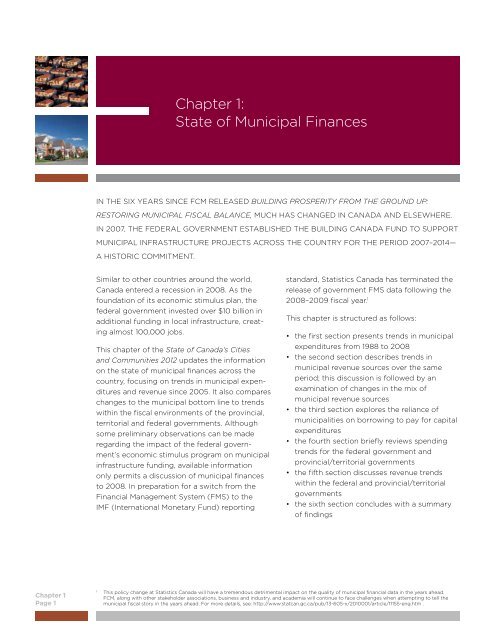The State of Canada's Cities and Communities 2012 - FCM
The State of Canada's Cities and Communities 2012 - FCM
The State of Canada's Cities and Communities 2012 - FCM
Create successful ePaper yourself
Turn your PDF publications into a flip-book with our unique Google optimized e-Paper software.
Chapter 1<br />
Page 1<br />
IN THE SIX YEARS SINCE <strong>FCM</strong> RELEASED BUILDING PROSPERITY FROM THE GROUND UP:<br />
RESTORING MUNICIPAL FISCAL BALANCE, MUCH HAS CHANGED IN CANADA AND ELSEWHERE.<br />
IN 2007, THE FEDERAL GOVERNMENT ESTABLISHED THE BUILDING CANADA FUND TO SUPPORT<br />
MUNICIPAL INFRASTRUCTURE PROJECTS ACROSS THE COUNTRY FOR THE PERIOD 2007–2014—<br />
A HISTORIC COMMITMENT.<br />
Chapter 1:<br />
<strong>State</strong> <strong>of</strong> Municipal Finances<br />
Similar to other countries around the world,<br />
Canada entered a recession in 2008. As the<br />
foundation <strong>of</strong> its economic stimulus plan, the<br />
federal government invested over $10 billion in<br />
additional funding in local infrastructure, creating<br />
almost 100,000 jobs.<br />
This chapter <strong>of</strong> the <strong>State</strong> <strong>of</strong> Canada’s <strong>Cities</strong><br />
<strong>and</strong> <strong>Communities</strong> <strong>2012</strong> updates the information<br />
on the state <strong>of</strong> municipal finances across the<br />
country, focusing on trends in municipal expenditures<br />
<strong>and</strong> revenue since 2005. It also compares<br />
changes to the municipal bottom line to trends<br />
within the fiscal environments <strong>of</strong> the provincial,<br />
territorial <strong>and</strong> federal governments. Although<br />
some preliminary observations can be made<br />
regarding the impact <strong>of</strong> the federal government’s<br />
economic stimulus program on municipal<br />
infrastructure funding, available information<br />
only permits a discussion <strong>of</strong> municipal finances<br />
to 2008. In preparation for a switch from the<br />
Financial Management System (FMS) to the<br />
IMF (International Monetary Fund) reporting<br />
st<strong>and</strong>ard, Statistics Canada has terminated the<br />
release <strong>of</strong> government FMS data following the<br />
2008–2009 fiscal year. 1<br />
This chapter is structured as follows:<br />
• the first section presents trends in municipal<br />
expenditures from 1988 to 2008<br />
• the second section describes trends in<br />
municipal revenue sources over the same<br />
period; this discussion is followed by an<br />
examination <strong>of</strong> changes in the mix <strong>of</strong><br />
municipal revenue sources<br />
• the third section explores the reliance <strong>of</strong><br />
municipalities on borrowing to pay for capital<br />
expenditures<br />
• the fourth section briefly reviews spending<br />
trends for the federal government <strong>and</strong><br />
provincial/territorial governments<br />
• the fifth section discusses revenue trends<br />
within the federal <strong>and</strong> provincial/territorial<br />
governments<br />
• the sixth section concludes with a summary<br />
<strong>of</strong> findings<br />
1 This policy change at Statistics Canada will have a tremendous detrimental impact on the quality <strong>of</strong> municipal financial data in the years ahead.<br />
<strong>FCM</strong>, along with other stakeholder associations, business <strong>and</strong> industry, <strong>and</strong> academia will continue to face challenges when attempting to tell the<br />
municipal fiscal story in the years ahead. For more details, see: http://www.statcan.gc.ca/pub/13-605-x/2010001/article/11155-eng.htm .

















